Identification and Quantification of Uncertainty Components in Gaseous and Particle Emission Measurements of a Moped
Abstract
1. Introduction
2. Materials and Methods
2.1. Experimental Setup
2.2. Theoretical Background
2.2.1. Solid Particle Number (SPN) Emissions
2.2.2. Exhaust Flow Rate
2.2.3. Cold Start
2.2.4. Particle Dynamics
2.2.5. Artefacts
3. Results
3.1. Exhaust Flow
3.2. CO2 and Gaseous Pollutants
3.3. Solid Particle Number (SPN)
4. Discussion
5. Conclusions
Author Contributions
Funding
Acknowledgments
Conflicts of Interest
Disclaimer
References
- Guerreiro, C.; González Ortiz, A.; de Leeuw, F.; Viana, M.; Colette, A.; European Environment Agency. Air Quality in Europe—2018 Report; European Environment Agency: Luxembourg, 2018; ISBN 978-929-213-989-6. [Google Scholar]
- Giechaskiel, B.; Lähde, T.; Suarez-Bertoa, R.; Clairotte, M.; Grigoratos, T.; Zardini, A.; Perujo, A.; Martini, G. Particle number measurements in the European legislation and future JRC activities. Combust. Engines 2018, 174, 3–16. [Google Scholar]
- Giechaskiel, B.; Mamakos, A.; Andersson, J.; Dilara, P.; Martini, G.; Schindler, W.; Bergmann, A. Measurement of automotive nonvolatile particle number emissions within the European legislative framework: A review. Aerosol Sci. Technol. 2012, 46, 719–749. [Google Scholar] [CrossRef]
- Giechaskiel, B.; Dilara, P.; Andersson, J. Particle measurement programme (PMP) light-duty inter-laboratory exercise: Repeatability and reproducibility of the particle number method. Aerosol Sci. Technol. 2008, 42, 528–543. [Google Scholar] [CrossRef]
- Giechaskiel, B.; Casadei, S.; Mazzini, M.; Sammarco, M.; Montabone, G.; Tonelli, R.; Deana, M.; Costi, G.; Di Tanno, F.; Prati, M.; et al. Inter-laboratory correlation exercise with portable emissions measurement systems (PEMS) on chassis dynamometers. Appl. Sci. 2018, 8, 2275. [Google Scholar] [CrossRef]
- Giechaskiel, B.; Joshi, A.; Ntziachristos, L.; Dilara, P. European regulatory framework and particulate matter emissions of gasoline light-duty vehicles: A review. Catalysts 2019, 9, 586. [Google Scholar] [CrossRef]
- Iodice, P.; Senatore, A. Exhaust emissions of new high-performance motorcycles in hot and cold conditions. Int. J. Environ. Sci. Technol. 2015, 12, 3133–3144. [Google Scholar] [CrossRef]
- European Commission, Directorate General for Mobility and Transport. EU Transport in Figures: Statistical Pocketbook; European Commission: Luxembourg, 2019; ISBN 978-92-76-03843-6. [Google Scholar]
- Platt, S.M.; Haddad, I.E.; Pieber, S.M.; Huang, R.J.; Zardini, A.A.; Clairotte, M.; Suarez-Bertoa, R.; Barmet, P.; Pfaffenberger, L.; Wolf, R.; et al. Two-stroke scooters are a dominant source of air pollution in many cities. Nat. Commun. 2014, 5, 3749. [Google Scholar] [CrossRef]
- Giechaskiel, B.; Zardini, A.; Martini, G. Particle emission measurements from L-category vehicles. SAE Int. J. Engines 2015, 8, 2322–2337. [Google Scholar] [CrossRef]
- Ntziachristos, L.; Vonk, W.A.; Papadopoulos, G.; van Mensch, P.; Geivanidis, S.; Mellios, G.; Papadimitriou, G.; Steven, H.; Elstgeest, M.; Ligterink, N.E.; et al. Effect Study of the Environmental Step Euro 5 for L-Category Vehicles; European Commission: Luxembourg, 2017; ISBN 978-92-79-70203-7. [Google Scholar]
- Kontses, A.; Ntziachristos, L.; Zardini, A.A.; Papadopoulos, G.; Giechaskiel, B. Particulate emissions from L-Category vehicles towards Euro 5. Env. Res. 2019. [Google Scholar]
- Giechaskiel, B.; Zardini, A.A.; Lähde, T.; Perujo, A.; Kontses, A.; Ntziachristos, L. Particulate emissions of Euro 4 motorcycles and sampling considerations. Atmosphere 2019, 10, 421. [Google Scholar] [CrossRef]
- Giechaskiel, B. Effect of sampling conditions on the sub-23 nm nonvolatile particle emissions measurements of a moped. Appl. Sci. 2019, 9, 3112. [Google Scholar] [CrossRef]
- Giechaskiel, B. Differences between tailpipe and dilution tunnel sub-23 nm non-volatile (solid) particle number measurements. Aerosol Sci. Technol. 2019, 1–13. [Google Scholar]
- Giechaskiel, B.; Vanhanen, J.; Väkevä, M.; Martini, G. Investigation of vehicle exhaust sub-23 nm particle emissions. Aerosol Sci. Technol. 2017, 51, 626–641. [Google Scholar] [CrossRef]
- Giechaskiel, B.; Schwelberger, M.; Delacroix, C.; Marchetti, M.; Feijen, M.; Prieger, K.; Andersson, S.; Karlsson, H.L. Experimental assessment of solid particle number portable emissions measurement systems (PEMS) for heavy-duty vehicles applications. J. Aerosol Sci. 2018, 123, 161–170. [Google Scholar] [CrossRef]
- Giechaskiel, B.; Lähde, T.; Drossinos, Y. Regulating particle number measurements from the tailpipe of light-duty vehicles: The next step? Environ. Res. 2019, 172, 1–9. [Google Scholar] [CrossRef] [PubMed]
- Czerwinski, J.; Comte, P.; Mayer, A.; Reutimann, F. Investigations of Changes of the 2-Stroke Scooters Nanoparticles in the Exhaust- and CVS-System; SAE International: Warrendale, PA, USA, 2013; 12p. [Google Scholar]
- Joint Committee for Guides in Metrology. JCGM 200:2012 International Vocabulary of Metrology–Basic and General Concepts and Associated Terms (VIM), 3rd ed.; Joint Committee for Guides in Metrology: Paris, France, 2008. [Google Scholar]
- Giechaskiel, B.; Clairotte, M.; Valverde-Morales, V.; Bonnel, P.; Kregar, Z.; Franco, V.; Dilara, P. Framework for the assessment of PEMS (portable emissions measurement systems) uncertainty. Environ. Res. 2018, 166, 251–260. [Google Scholar] [CrossRef] [PubMed]
- Joint Committee for Guides in Metrology. JCGM 100:2008 Evaluation of Measurement Data—Guide to the Expression of Uncertainty in Measurement (GUM); Joint Committee for Guides in Metrology: Paris, France, 2008. [Google Scholar]
- Vasic, A.M.; Weilenmann, M. Comparison of real-world emissions from two-wheelers and passenger cars. Environ. Sci. Technol. 2006, 40, 149–154. [Google Scholar] [CrossRef]
- Giechaskiel, B.; Cresnoverh, M.; Jörgl, H.; Bergmann, A. Calibration and accuracy of a particle number measurement system. Meas. Sci. Technol. 2010, 21, 045102. [Google Scholar] [CrossRef]
- Takegawa, N.; Sakurai, H. Laboratory evaluation of a TSI condensation particle counter (model 3771) under airborne measurement conditions. Aerosol Sci. Technol. 2011, 45, 272–283. [Google Scholar] [CrossRef]
- Giechaskiel, B.; Bergmann, A. Validation of 14 used, re-calibrated and new TSI 3790 condensation particle counters according to the UN-ECE Regulation 83. J. Aerosol Sci. 2011, 42, 195–203. [Google Scholar] [CrossRef]
- Tsai, J.H.; Huang, P.H.; Chiang, H.L. Air pollutants and toxic emissions of various mileage motorcycles for ECE driving cycles. Atmos. Environ. 2017, 153, 126–134. [Google Scholar] [CrossRef]
- Zardini, A.A.; Platt, S.M.; Clairotte, M.; El Haddad, I.; Temime-Roussel, B.; Marchand, N.; Ježek, I.; Drinovec, L.; Močnik, G.; Slowik, J.G.; et al. Effects of alkylate fuel on exhaust emissions and secondary aerosol formation of a 2-stroke and a 4-stroke scooter. Atmos. Environ. 2014, 94, 307–315. [Google Scholar] [CrossRef]
- Zardini, A.A.; Suarez-Bertoa, R.; Dardiotis, C.; Astorga, C. Unregulated pollutants from tampered two-wheelers. Transp. Res. Procedia 2016, 14, 3109–3118. [Google Scholar] [CrossRef]
- Clairotte, M.; Adam, T.W.; Chirico, R.; Giechaskiel, B.; Manfredi, U.; Elsasser, M.; Sklorz, M.; DeCarlo, P.F.; Heringa, M.F.; Zimmermann, R.; et al. Online characterization of regulated and unregulated gaseous and particulate exhaust emissions from two-stroke mopeds: A chemometric approach. Anal. Chim. Acta 2012, 717, 28–38. [Google Scholar] [CrossRef]
- Spezzano, P.; Picini, P.; Cataldi, D.; Messale, F.; Manni, C. Particle- and gas-phase emissions of polycyclic aromatic hydrocarbons from two-stroke, 50-cm3 mopeds. Atmos. Environ. 2008, 42, 4332–4344. [Google Scholar] [CrossRef]
- Prati, M.V.; Costagliola, M.A. Emissions of fine particles and organic compounds from mopeds. Environ. Eng. Sci. 2009, 26, 111–122. [Google Scholar] [CrossRef]
- Zardini, A.; Clairotte, M.; Lanappe, G.; Giechaskiel, B.; Martini, G. Preparatory Work for the Environmental Effect Study on the Euro 5 Step of L-Category Vehicles; Publications Office: Luxembourg, 2016. [Google Scholar]
- Varella, R.; Giechaskiel, B.; Sousa, L.; Duarte, G. Comparison of Portable Emissions Measurement Systems (PEMS) with Laboratory Grade Equipment. Appl. Sci. 2018, 8, 1633. [Google Scholar] [CrossRef]
- Mohanta, L.; Iyer, S.; Mishra, P.; Klinikowski, D. Uncertainties in Measurements of Emissions in Chassis Dynamometer Tests; SAE International: Warrendale, PA, USA, 2014. [Google Scholar]
- Geivanidis, S.; Samaras, Z. Development of a dynamic model for the reconstruction of tailpipe emissions from measurements on a constant volume sampling dilution system. Meas. Sci. Technol. 2008, 19, 015404. [Google Scholar] [CrossRef]
- Mahadevan, V.; Iyer, S.; Klinikowski, D. Recovery of tail pipe species concentrations and its effect on emissions calculations from raw exhaust gas streams during chassis dynamometer tests. SAE Int. J. Engines 2016, 9, 1763–1774. [Google Scholar] [CrossRef]
- Ajtay, D.; Weilenmann, M. Compensation of the exhaust gas transport dynamics for accurate instantaneous emission measurements. Environ. Sci. Technol. 2004, 38, 5141–5148. [Google Scholar] [CrossRef]
- Weilenmann, M.; Soltic, P.; Ajtay, D. Describing and compensating gas transport dynamics for accurate instantaneous emission measurement. Atmos. Environ. 2003, 37, 5137–5145. [Google Scholar] [CrossRef]
- Adachi, M.; Nakamura, H. Engine Emissions Measurement Handbook: HORIBA Automotive Test Systems; SAE International: Warrendale, PA, USA, 2014; ISBN 978-076-808-012-4. [Google Scholar]
- Zardini, A.A.; Suarez-Bertoa, R.; Forni, F.; Montigny, F.; Otura-Garcia, M.; Carriero, M.; Astorga, C. Reducing the exhaust emissions of unregulated pollutants from small gasoline engines with alkylate fuel and low-ash lube oil. Environ. Res. 2019, 170, 203–214. [Google Scholar] [CrossRef] [PubMed]
- Giechaskiel, B.; Zardini, A.A.; Clairotte, M. Exhaust gas condensation during engine cold start and application of the dry-wet correction factor. Appl. Sci. 2019, 9, 2263. [Google Scholar] [CrossRef]
- Isella, L.; Giechaskiel, B.; Drossinos, Y. Diesel-exhaust aerosol dynamics from the tailpipe to the dilution tunnel. J. Aerosol Sci. 2008, 39, 737–758. [Google Scholar] [CrossRef]
- Giechaskiel, B.; Arndt, M.; Schindler, W.; Bergmann, A.; Silvis, W.; Drossinos, Y. Sampling of non-volatile vehicle exhaust particles: A simplified guide. SAE Int. J. Engines 2012, 5, 379–399. [Google Scholar] [CrossRef]
- Mathis, U.; Ristimäki, J.; Mohr, M.; Keskinen, J.; Ntziachristos, L.; Samaras, Z.; Mikkanen, P. Sampling conditions for the measurement of nucleation mode particles in the exhaust of a diesel vehicle. Aerosol Sci. Technol. 2004, 38, 1149–1160. [Google Scholar] [CrossRef]
- Keskinen, J.; Rönkkö, T. Can real-world diesel exhaust particle size distribution be reproduced in the laboratory? A critical review. J. Air Waste Manag. Assoc. 2010, 60, 1245–1255. [Google Scholar] [CrossRef]
- Giechaskiel, B.; Drossinos, Y. Theoretical investigation of volatile removal efficiency of particle number measurement systems. SAE Int. J. Engines 2010, 3, 1140–1151. [Google Scholar] [CrossRef]
- Hawley, J.G.; Bannister, C.D.; Brace, C.J.; Cox, A.; Ketcher, D.; Stark, R. Vehicle modal emissions measurement—Techniques and issues. Proc. Inst. Mech. Eng. Part D J. Automob. Eng. 2004, 218, 859–873. [Google Scholar] [CrossRef]
- Giechaskiel, B.; Lähde, T.; Schwelberger, M.; Kleinbach, T.; Roske, H.; Teti, E.; van den Bos, T.; Neils, P.; Delacroix, C.; Jakobsson, T.; et al. Particle number measurements directly from the tailpipe for type approval of heavy-duty engines. Appl. Sci. 2019, 9, 4418. [Google Scholar] [CrossRef]
- Giechaskiel, B. Solid particle number emission factors of Euro VI heavy-duty vehicles on the road and in the laboratory. IJERPH 2018, 15, 304. [Google Scholar] [CrossRef] [PubMed]
- Mamakos, A.; Schwelberger, M.; Fierz, M.; Giechaskiel, B. Effect of selective catalytic reduction on exhaust nonvolatile particle emissions of Euro VI heavy-duty compression ignition vehicles. Aerosol Sci. Technol. 2019, 53, 898–910. [Google Scholar] [CrossRef]
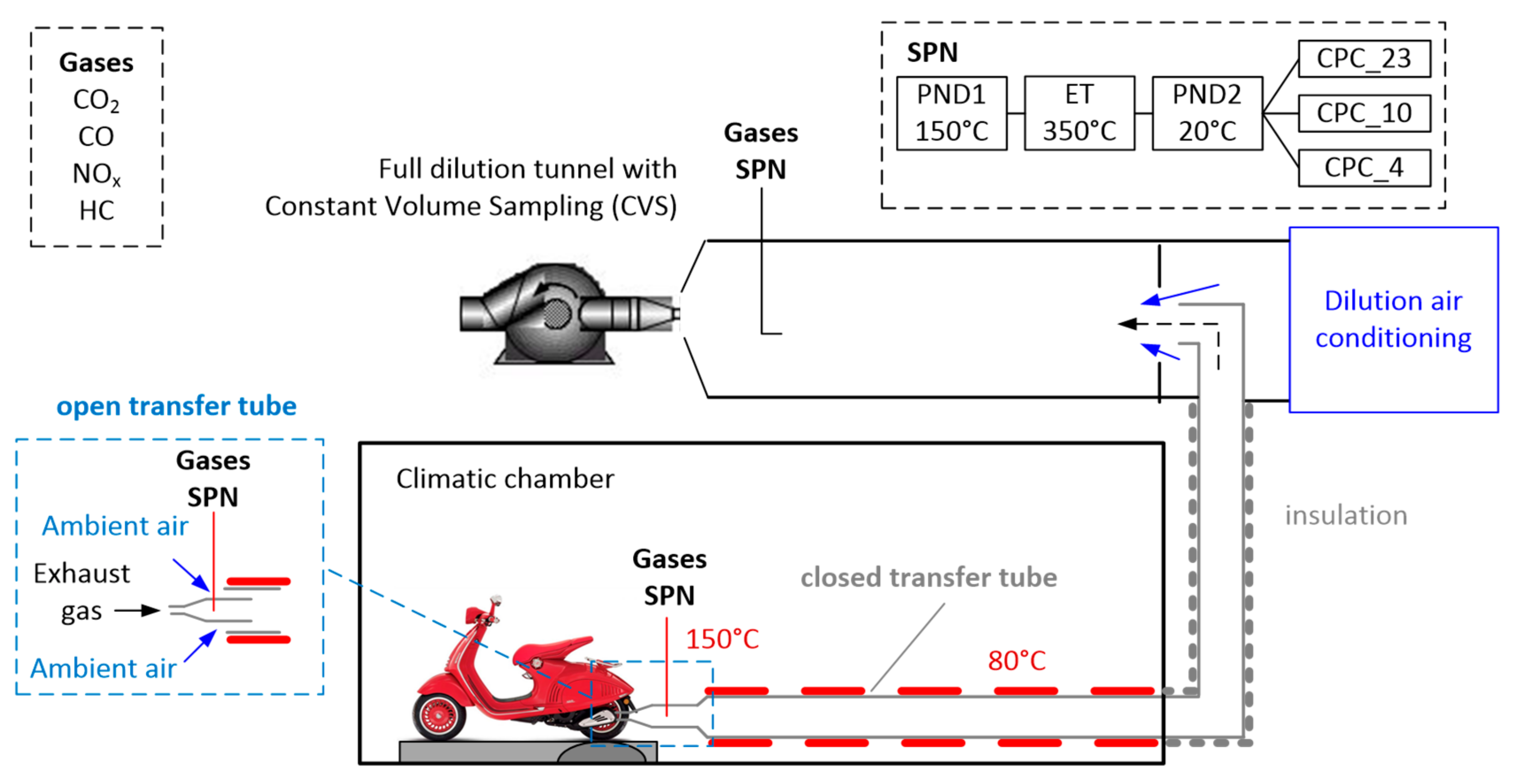
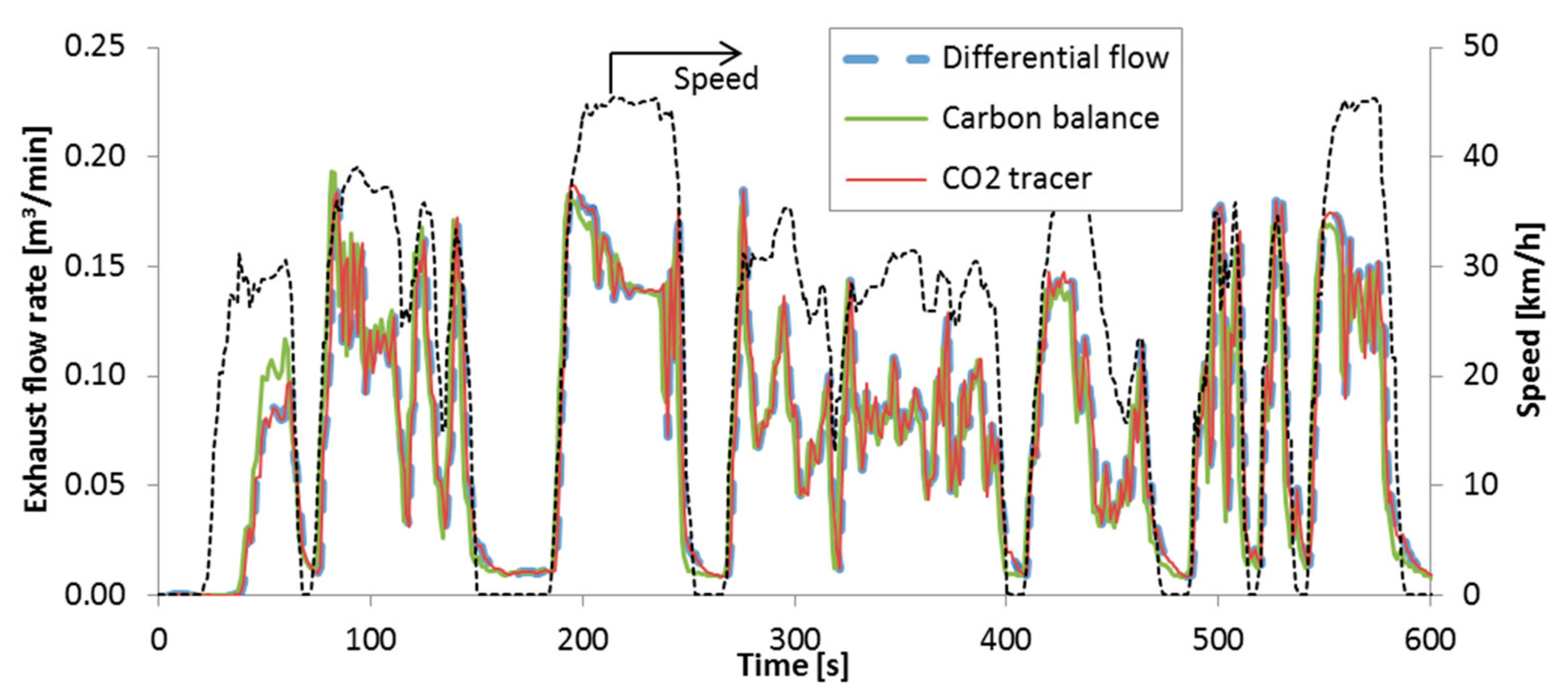
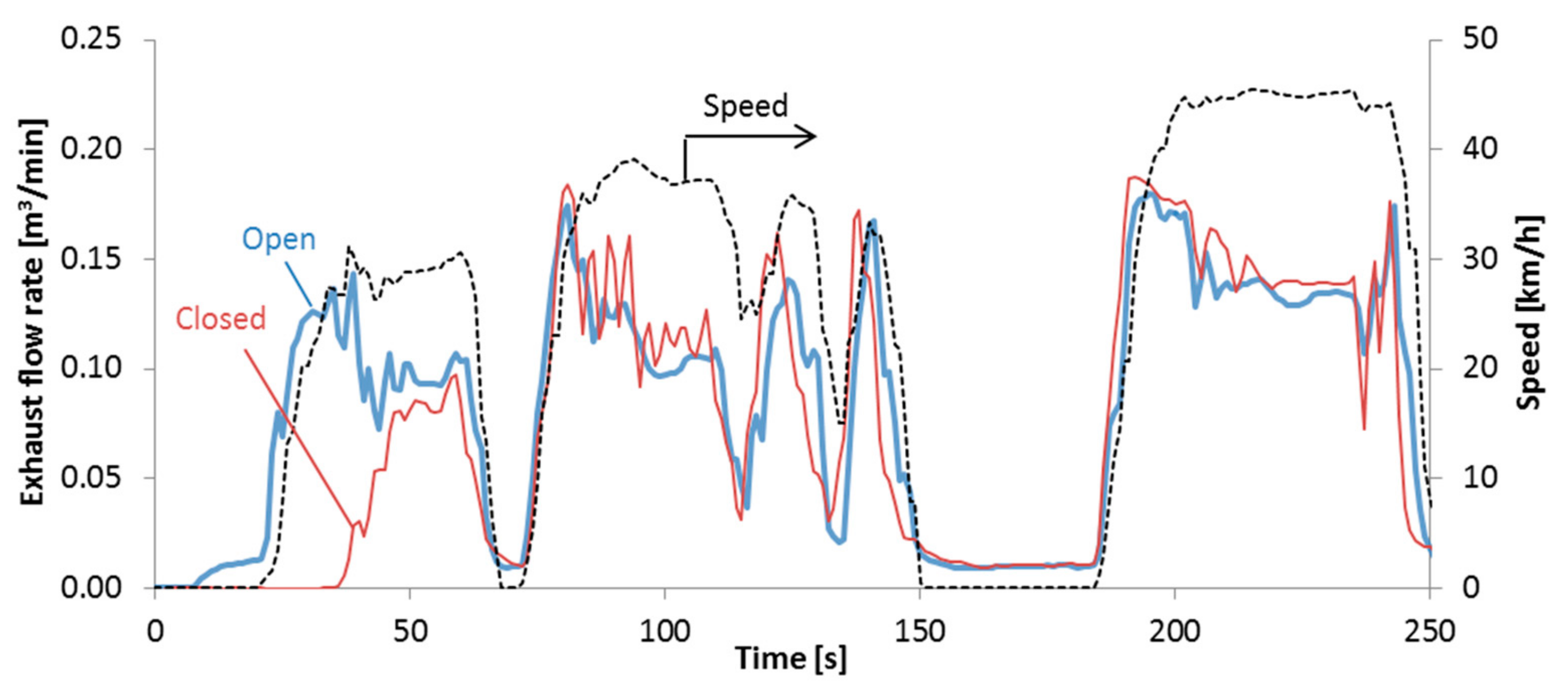
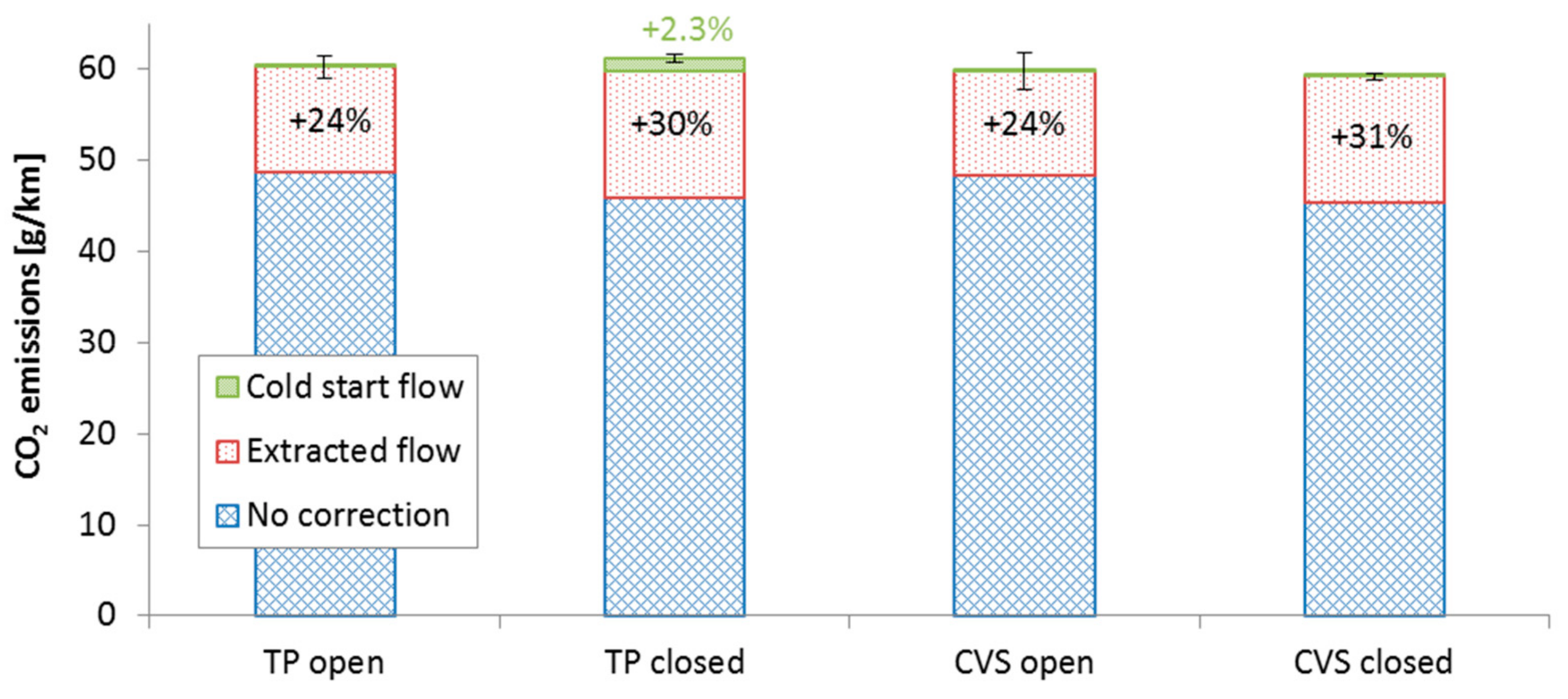
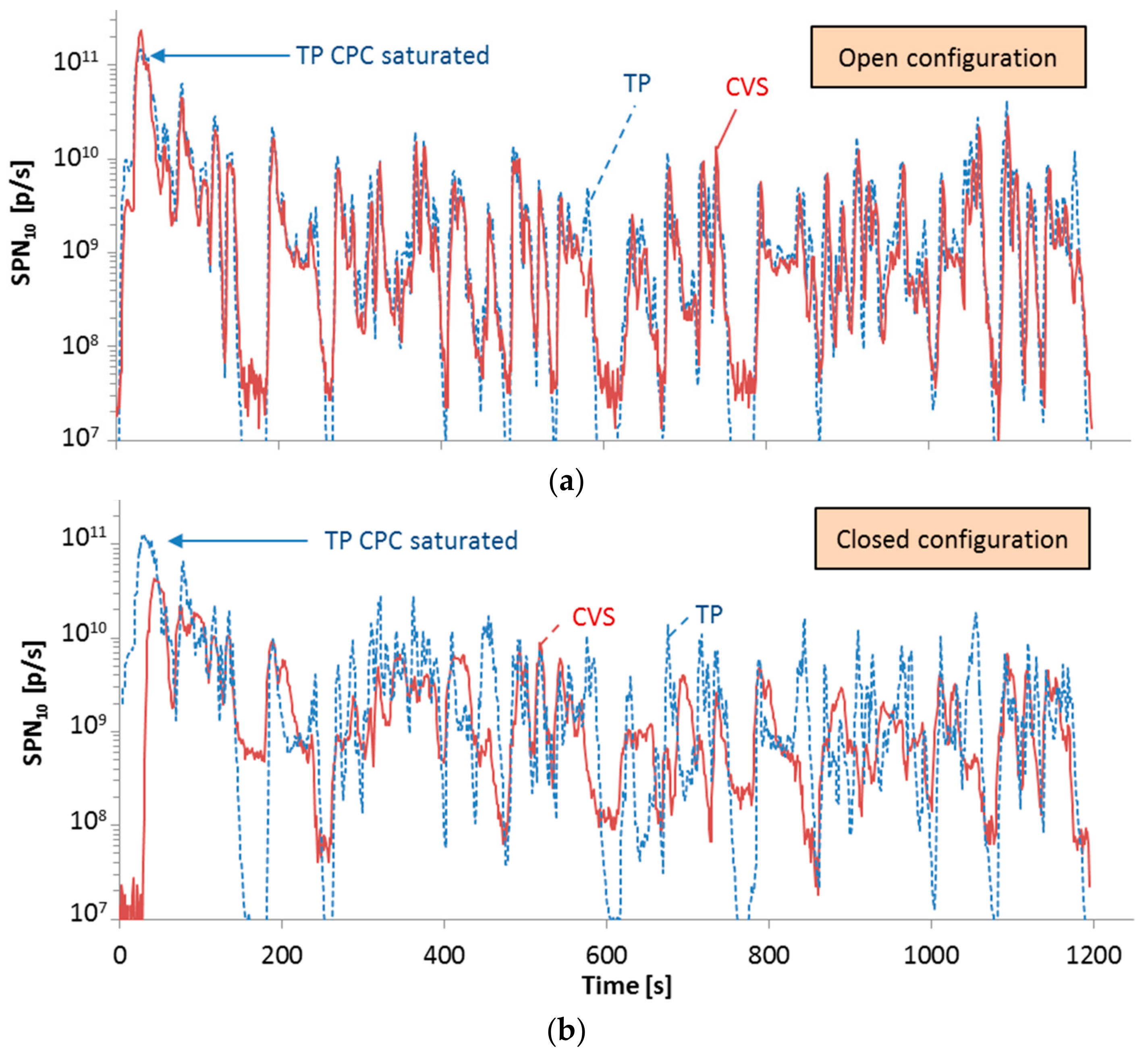
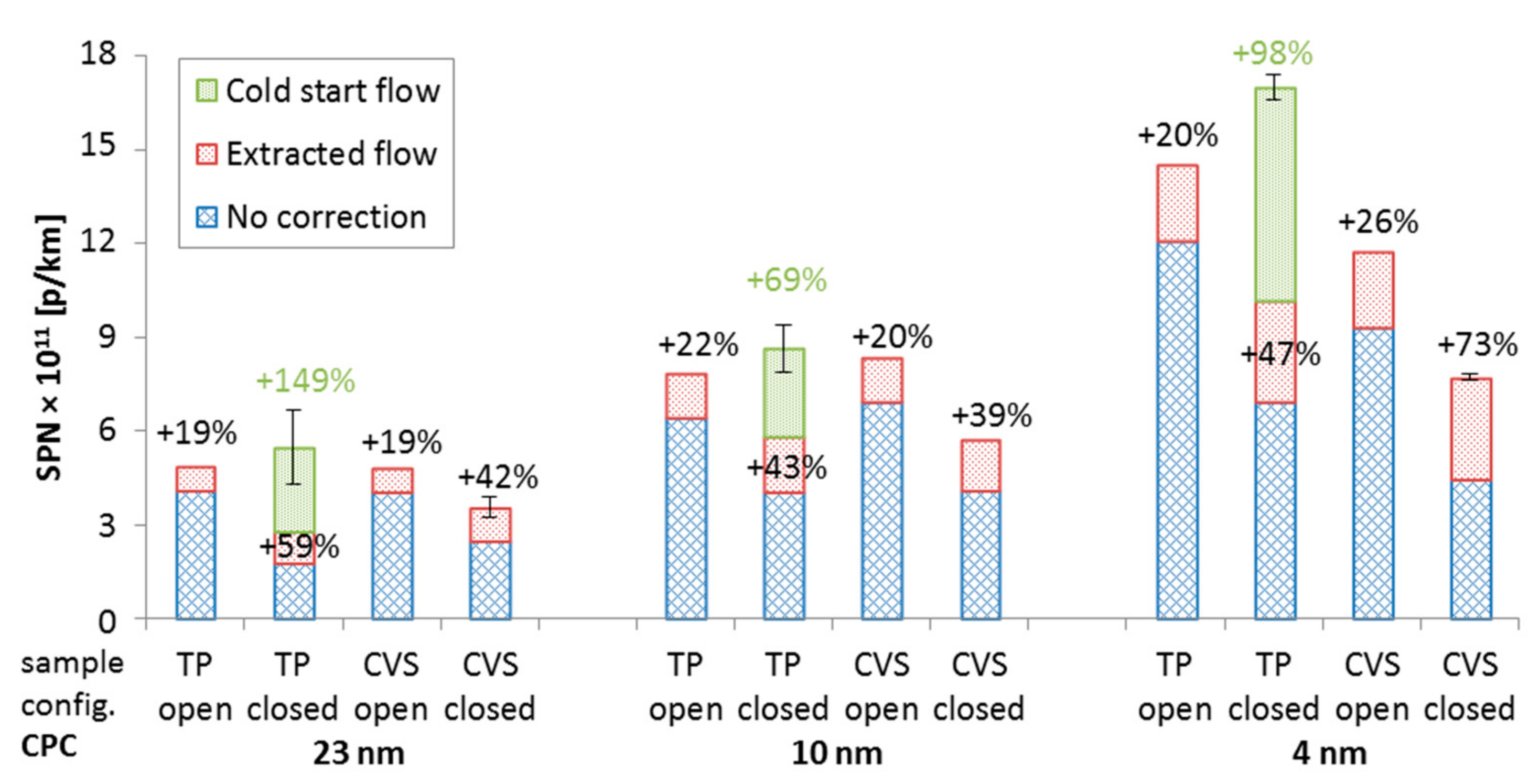
| TP Open | TP Closed | CVS Open | CVS Closed | Comments | |
|---|---|---|---|---|---|
| Exhaust flow | Y | Y | N | N | Depends on the method. In this study ±5% |
| Extracted flow | Y | Y | Y | Y | The effect can be assumed similar to the extracted flow (CO2) or higher (SPN) (>25% in this study) |
| Dead volume of transfer line | N | (Y) | N | Y | Will affect exhaust flow determination, (depending on the method) due to gas mixing and dispersion. Effect on SPN >50% in this study |
| Concentrations | Y | Y | N | N | Cold start concentrations might exceed max range of tailpipe instruments |
| Particle losses | N | N | N | Y | Not for gases. Agglomeration for concentrations >1 × 107 p/cm3; 30% effect for peaks >1 × 108 p/cm3 |
| Misalignment | Y | Y | N | N | For ±1 s, in this study around ±5% |
© 2019 by the authors. Licensee MDPI, Basel, Switzerland. This article is an open access article distributed under the terms and conditions of the Creative Commons Attribution (CC BY) license (http://creativecommons.org/licenses/by/4.0/).
Share and Cite
Giechaskiel, B.; Zardini, A.A.; Lähde, T.; Clairotte, M.; Forloni, F.; Drossinos, Y. Identification and Quantification of Uncertainty Components in Gaseous and Particle Emission Measurements of a Moped. Energies 2019, 12, 4343. https://doi.org/10.3390/en12224343
Giechaskiel B, Zardini AA, Lähde T, Clairotte M, Forloni F, Drossinos Y. Identification and Quantification of Uncertainty Components in Gaseous and Particle Emission Measurements of a Moped. Energies. 2019; 12(22):4343. https://doi.org/10.3390/en12224343
Chicago/Turabian StyleGiechaskiel, Barouch, Alessandro A. Zardini, Tero Lähde, Michael Clairotte, Fabrizio Forloni, and Yannis Drossinos. 2019. "Identification and Quantification of Uncertainty Components in Gaseous and Particle Emission Measurements of a Moped" Energies 12, no. 22: 4343. https://doi.org/10.3390/en12224343
APA StyleGiechaskiel, B., Zardini, A. A., Lähde, T., Clairotte, M., Forloni, F., & Drossinos, Y. (2019). Identification and Quantification of Uncertainty Components in Gaseous and Particle Emission Measurements of a Moped. Energies, 12(22), 4343. https://doi.org/10.3390/en12224343






